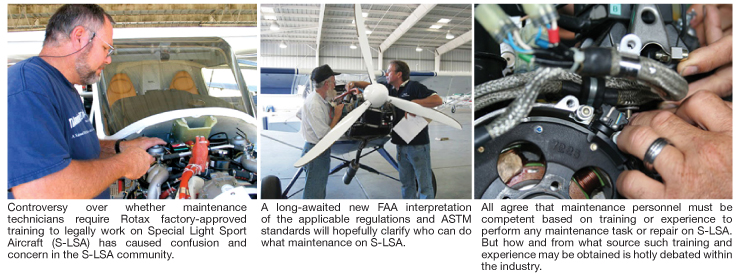by Carol Carpenter, Rainbow Aviation Services
As expected, the adoption of the Sport Pilot/Light Sport Aircraft Rule in 2004, and the FAA interpretation requiring, in some cases, “Manufacturer’s Factory Approved Training” to provide service and line maintenance to Special Light Sport Aircraft (S-LSA), have caused more than a few ripples among aviation maintenance professionals. The Rotax Factory Training Courses are at the center of this controversy. Now, after almost a year of review, the FAA is expected to issue its “New Interpretation” of training requirements and its latest stand on S-LSA manufacturer’s programs.
This “New Interpretation,” to be published soon, is expected to relate to the following areas:
1. Manufacturers’ required training;
2. Manufacturers issuing “certification; and
3. Manufacturers’ required recurrent training programs.
These developments are the result of a formal complaint and the FAA’s response to that complaint.
The Rotax Position
The issues surrounding Rotax Factory Approved Training are complex. On the one hand, we have the Rotax position, expressed by Eric Tucker, the company representative in the U.S.: “We require the engine be maintained by a Rotax factory trained technician. Our section (in the maintenance manual) on Authorized Personnel clearly requires Rotax-specific training.“ Tucker explains the company policy by asserting that, “Working under supervision of someone with training is completely different than getting training. Not everyone is an instructor and not everyone will evaluate (individuals) the same.”
Furthermore, it is Eric’s understanding that the Statement of Compliance, by which Rotax engines are certified, requires Rotax factory training to be valid, since the airworthiness certification is based on this document. This was also the position taken by the FAA until about one year ago when a formal complaint was filed against an A&P mechanic, forcing the agency to look deeper into this issue.
The Challenger’s Position
The formal complaint made the following argument regarding the FAA’s original interpretation. The Rotax maintenance manual requires factory-approved training before performing any maintenance on any Rotax engine installed on S-LSA. This Rotax requirement subsequently has become regulatory based on the Statement of Compliance issued regarding the engine. This process, in effect, allows a manufacturer to create law. Under our legal system, laws cannot be made by manufacturers, or potentially any individual, but only by legislatures or administrative agencies with legislative approval.
The Rotax Response
Rotax responded in a formal letter to the FAA, citing FAR 65.81 as one basis for their factory-training requirement. This regulation provides: However, he may not supervise the maintenance, preventive maintenance, or alteration of, or approve and return to service, any aircraft or appliance, or part thereof, for which he is rated unless he has satisfactorily performed the work concerned at an earlier date. In the Rotax view, this must start with approved factory training.
The Likely FAA “New Interpretation”
However, FAR 65.81 only requires, in most cases, that the mechanic use his or her own good judgment. He or she is overseen, in effect, by the FAA, not by an individual or a manufacturer. FAR 65.81 goes on to say that if someone has not successfully completed the subject work at an earlier date, he or she may show their ability to do so by performing the task to the satisfaction of the Administrator (FAA) or an appropriately- rated mechanic or repairman who has previous experience with the operation concerned. It says nothing about factory training. This regulation certainly cannot be read to support an enforcement action against an aviation technician who is trained by, say, another technician to service a Rotax engine.
So, after a long and arduous process, the FAA, upon advice of its legal counsel in Washington, D.C., is expected to say that a technician must have training, but it does not have to be Rotax Factory Training. Rotax factory-trained individuals will have the option to take the two-year recurrent training offered by Rotax, but since it is not required by the regulations, the Rotax requirement for recurrent training is not considered regulatory. (But remember, there are many things that may be legal, but would not be wise.)
Stay Tuned
We are eagerly waiting for this new FAA guidance to be issued and I will post a link on our website and on this site when it is issued. Also look for my follow-up article on the final guidance. For now, the FAA in Washington, D.C. has directed the Airframe and Powerplant mechanic who was the subject of the formal complaint back to work on Rotax engines, and acknowledged that he is not required by law to attend any of the Rotax Factory Training. (By the way, the FAA has hinted that we can look for a lot of changes within our regulations in the next two to five years.) It is important to note that the regulations do require that we have the proper training, that we use the proper tools, and that we follow the proper procedures when working on Rotax engines.
But for now, the bottom line is that maintenance on S-LSA, like type-certificated aircraft, shall be performed in accordance with the Federal Aviation Regulations, specifically Title 14 CFR Part 43. Period. Any exceptions are contained within the regulation itself. If the FARs incorporate consensus standards by reference, then those consensus standards (and only those, or the specific parts of them referenced) become regulatory. I expect that we will see a few of those consensus standards incorporated into maintenance regulations in the near future. Stay tuned.











